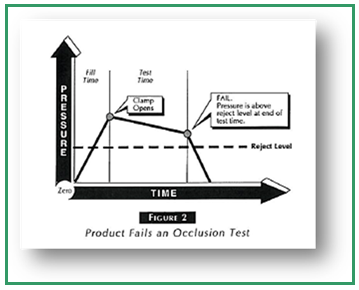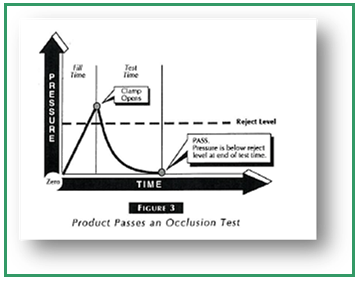Many devices are constructed with passages that must remain open if the product is to function normally when used. During the manufacturing process, it is sometimes possible to inadvertently create a blockage in a passage thus affecting the quality and performance of the device. This will necessitate an occlusion test.
An occlusion is a complete or partial obstruction of a pathway that is not part of its design. It might be a piece of plastic in a catheter, it might be a burr in a gas pipe or it might be something else. In any event it will affect the performance of the product and in a medical device, for example, there could be serious consequences. Therefore the occlusion test should always be considered where a desired flow is part of the product function.
It is often necessary to test product to make sure pathways are open and have not become blocked or partially obstructed. This functional evaluation is generally referred to as “occlusion testing.”
When checking products for possible blockage, test engineers are frequently concerned with testing speed and repeatability.
The SprintmD Solution
SprintmD testers can conduct occlusion tests by using a pressure drop technique. In this test, the product must drop below a preset pressure (reject level) to pass the test; which is the opposite of a normal leak test.
The same basic pneumatic circuit employed in pressure decay testing is used in occlusion testing but the programming is different.
Thanks to the commonality of test circuits, it is possible (and quite common) to conduct pressure decay tests followed by occlusion tests. This is easy to accomplish with SprintmD’s program linking capability.
How The SprintmD Occlusion Test Works
SprintmD tests for occlusion like this:
1. Product is attached to Sprint mD ’s test port and the open end of the product is placed in the clamping fixture. (Figure 1)
2. The test is started.
3. The open end of the product is sealed off by the clamping device and the product is then pressurized through valve V1 for the duration set for fill time.
4. At the end of fill time, the fill valve V1 closes and the seal opens the product to atmosphere. Sprint mD advances to test time in which it looks for a pressure decrease using sensor S.
5. Based on set-points entered into the test program, Sprint mD determines whether the product is accepted or rejected.
6. At the end of test time, valve V2 opens to vent any remaining pressure to atmosphere.
Pressure & Time Sequence

Figure 2 illustrates a typical occlusion test sequence in which the product under test fails the evaluation.
The product is pressurized while the clamping fixture seals the open end of the product. At the conclusion of fill time, the fill valve closes and traps air in the test circuit. The SprintmD sequences to test time, the clamp valve opens to atmosphere, ant he tester measures the air pressure that escapes from the product.
In this example, the product fails because the air loss from the product was not great enough to drop below the reject level in the allowed test time.
Figure 3 shows a typical occlusion test in which the product passes the evaluation.

The product is pressurized while the clamping fixture seals the open end of the product. As shown in Figure 3, the pressure drops below the reject limit within the established test time after the sealing clamp opens and allows the product to flow to atmosphere.
The significant pressure drop in the product indicates that the device under test flows freely to atmosphere and thus is not blocked.
Applications:
SprintmD occlusion testers can be used to test tubes, valves, and devices that must flow a minimum volume of air. Consider using a SprintmD occlusion test in conjunction with a leak test. Depending on the product, multiple occlusion tests can be conducted either sequentially or concurrently.
Features:
- Test parameters are easy to program
- All components are in one small enclosure
- Small footprint
- Perfect for bench or automation
- High pressure resolution
- Can be combined with other test types
- Can read in cubic centimeters per minute
Ask An Expert!
If you would like more information about the Sprint mD tester, or Occlusion Testing, contact us to speak with one of our leak testing experts, or contact your local Uson representative .